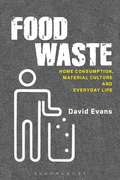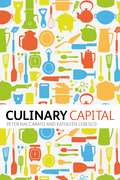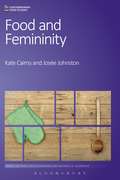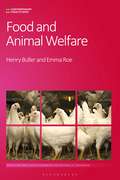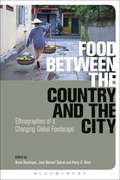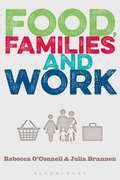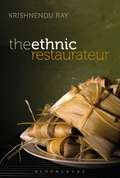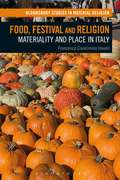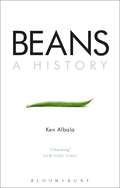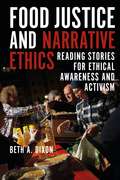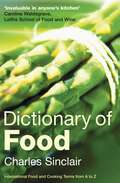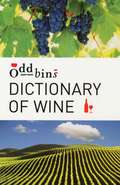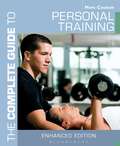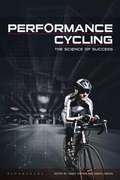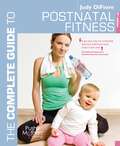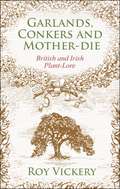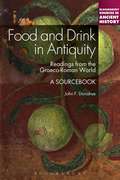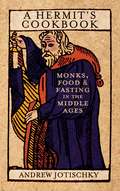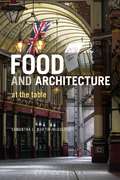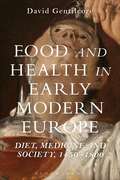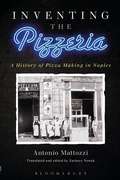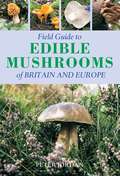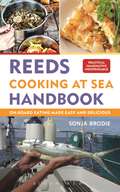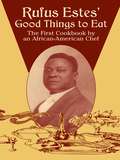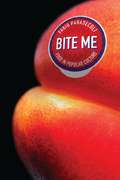- Table View
- List View
Food Waste: Home Consumption, Material Culture and Everyday Life (Materializing Culture)
by David EvansIn recent years, food waste has risen to the top of the political and public agenda, yet until now there has been no scholarly analysis applied to the topic as a complement and counter-balance to campaigning and activist approaches. Using ethnographic material to explore global issues, Food Waste unearths the processes that lie behind the volume of food currently wasted by households and consumers. The author demonstrates how waste arises as a consequence of households negotiating the complex and contradictory demands of everyday life, explores the reasons why surplus food ends up in the bin, and considers innovative solutions to the problem.Drawing inspiration from studies of consumption and material culture alongside social science perspectives on everyday life and the home, this lively yet scholarly book is ideal for students and researchers from a wide range of disciplines, along with anyone interested in understanding the food that we waste.
Culinary Capital
by Peter Naccarato Kathleen LebescoTV cookery shows hosted by celebrity chefs. Meal prep kitchens. Online grocers and restaurant review sites. Competitive eating contests, carnivals and fairs, and junk food websites and blogs. What do all of them have in common? According to authors Kathleen LeBesco and Peter Naccarato, they each serve as productive sites for understanding the role of culinary capital in shaping individual and group identities in contemporary culture.Beyond providing sustenance, food and food practices play an important social role, offering status to individuals who conform to their culture's culinary norms and expectations while also providing a means of resisting them. Culinary Capital analyzes this phenomenon in action across the landscape of contemporary culture. The authors examine how each of the sites listed above promises viewers and consumers status through the acquisition of culinary capital and, as they do so, intersect with a range of cultural values and ideologies, particularly those of gender and economic class.
Food and Femininity (Contemporary Food Studies: Economy, Culture and Politics)
by Kate Cairns Josée JohnstonOver the space of a few generations, women's relationship with food has changed dramatically. Yet – despite significant advances in gender equality – food and femininity remain closely connected in the public imagination as well as the emotional lives of women. While women encounter food-related pressures and pleasures as individuals, the social challenge to perform food femininities remains: as the nurturing mother, the talented home cook, the conscientious consumer, the svelte and health-savvy eater. In Food and Femininity, Kate Cairns and Josée Johnston explore these complex and often emotionally-charged tensions to demonstrate that food is essential to the understanding of femininity today. Drawing on extensive qualitative research in Toronto, they present the voices of over 100 food-oriented men and women from a range of race and class backgrounds. Their research reveals gendered expectations to purchase, prepare, and enjoy food within the context of time crunches, budget restrictions, political commitments, and the pressure to manage health and body weight. The book analyses how women navigate multiple aspects of foodwork for themselves and others, from planning meals, grocery shopping, and feeding children, to navigating conflicting preferences, nutritional and ethical advice, and the often-inequitable division of household labour. What emerges is a world in which women's choices continue to be closely scrutinized – a world where 'failing' at food is still perceived as a failure of femininity.A compelling rethink of contemporary femininity, this is an indispensable read for anyone interested in the sociology of food, gender studies and consumer culture.
Food and Animal Welfare (Contemporary Food Studies: Economy, Culture and Politics)
by Henry Buller Emma RoeDrawing together the latest research and a range of case studies, Henry Buller and Emma Roe guide readers on a fascinating journey through animal welfare issues 'from farm to fork'. Animal welfare offers a vital lens through which to explore the economies, culture and politics of food. This is the first text to provide a much-needed overview of this strongly debated area of the food industry.Buller and Roe explore how animal welfare is defined, advocated, assessed and implemented by farmers, veterinarians, distributors, and consumers. From the practicalities and limitations of establishing a basic standard of care for livestock, to the ethics of selling welfare as a product in the supermarket, this indispensable book offers empirical insights into a key aspect of the global food system: the lives, deaths, and consumption of animals which are at the core of the food chain. It is a must-read for students and scholars of animal welfare, agro-food studies and human-animal relations in disciplines such as geography, politics, anthropology, and sociology as well as animal behaviour, psychology and veterinary science.
Food Between the Country and the City: Ethnographies of a Changing Global Foodscape
by Nuno Domingos José Manuel Sobral Harry G. WestAt a time when the relationship between 'the country' and 'the city' is in flux worldwide, the value and meanings of food associated with both places continue to be debated. Building upon the foundation of Raymond Williams' classic work, The Country and the City, this volume examines how conceptions of the country and the city invoked in relation to food not only reflect their changing relationship but have also been used to alter the very dynamics through which countryside and cities, and the food grown and eaten within them, are produced and sustained. Leading scholars in the study of food offer ethnographic studies of peasant homesteads, family farms, community gardens, state food industries, transnational supermarkets, planning offices, tourist boards, and government ministries in locales across the globe. This fascinating collection provides vital new insight into the contested dynamics of food and will be key reading for upper-level students and scholars of food studies, anthropology, history and geography.
Food, Families and Work
by Rebecca O'Connell Julia BrannenWith dual-working households now the norm, Food, Families and Work is the first comprehensive study to explore how families negotiate everyday food practices in the context of paid employment.As the working hours of British parents are among the highest in Europe, the United Kingdom provides a key case study for investigating the relationship between parental employment and family food practices. Focusing on issues such as the gender division of foodwork, the impact of family income on diet, family meals, and the power children wield over the food they eat, the book offers a longitudinal view of family routines. It explores how the everyday meanings of food change as children grow older and negotiate changes in their own lives and those of their family members. Drawing on extensive quantitative data from large-scale surveys of food and diet – as well as qualitative evidence – to emphasise the larger global context of social and economic change and shifting patterns of family life, Rebecca O'Connell and Julia Brannen present a holistic overview of food practices within busy contemporary family lives. Featuring perspectives from both parents and children, this innovative approach to some of the most hotly-debated topics in food studies is a must-read for students and scholars in food studies, sociology, anthropology, nutrition and public health.
The Ethnic Restaurateur
by Krishnendu RayAcademic discussions of ethnic food have tended to focus on the attitudes of consumers, rather than the creators and producers. In this ground-breaking new book, Krishnendu Ray reverses this trend by exploring the culinary world from the perspective of the ethnic restaurateur. Focusing on New York City, he examines the lived experience, work, memories, and aspirations of immigrants working in the food industry. He shows how migrants become established in new places, creating a taste of home and playing a key role in influencing food cultures as a result of transactions between producers, consumers and commentators.Based on extensive interviews with immigrant restaurateurs and students, chefs and alumni at the Culinary Institute of America, ethnographic observation at immigrant eateries and haute institutional kitchens as well as historical sources such as the US census, newspaper coverage of restaurants, reviews, menus, recipes, and guidebooks, Ray reveals changing tastes in a major American city between the late 19th and through the 20th century. Written by one of the most outstanding scholars in the field, The Ethnic Restaurateur is an essential read for students and academics in food studies, culinary arts, sociology, urban studies and indeed anyone interested in popular culture and cooking in the United States.
Food, Festival and Religion: Materiality and Place in Italy (Bloomsbury Studies in Material Religion)
by Francesca Ciancimino HowellFood, Festival and Religion explores how communities in northern Italy find a restorative sense of place through foodways, costuming and other forms of materiality. Festivals examined by the author vary geographically from the northern rural corners of Italy to the fashionable heart of urban Milan. The origins of these lived religious events range from Christian to vernacular Italian witchcraft and contemporary Paganism, which is rapidly growing in Italy. Francesca Ciancimino Howell demonstrates that during ritualized occasions the sacred is located within the mundane. She argues that communal feasting, pilgrimage, rituals and costumed events can represent forms of lived religious materiality. Building on the work of scholars including Foucault, Grimes and Ingold, Howell offers a theoretical “Scale of Engagement” which further tests the interfaces between and among the materialities of place, food, ritual and festivals and provides a widely-applicable model for analyzing grassroots events and community initiatives.Through extensive ethnographic research and fieldwork data, this book demonstrates that popular Italian festivals can be ritualized, liminal spaces, contributing greatly to the fields of religious, performance and ritual studies.
Beans: A History
by Ken AlbalaThis is the story of the bean, the staple food cultivated by humans for over 10,000 years. From the lentil to the soybean, every civilization on the planet has cultivated its own species of bean. The humble bean has always attracted attention - from Pythagoras' notion that the bean hosted a human soul to St. Jerome's indictment against bean-eating in convents (because they "tickle the genitals"), to current research into the deadly toxins contained in the most commonly eaten beans. Over time, the bean has been both scorned as "poor man's meat" and praised as health-giving, even patriotic. Attitudes to this most basic of foodstuffs have always revealed a great deal about a society. Featuring a new preface from author Ken Albala, Beans: A History takes the reader on a fascinating journey across cuisines and cultures.
Food Justice and Narrative Ethics: Reading Stories for Ethical Awareness and Activism
by Beth A. DixonBeth A. Dixon explores how food justice impacts on human lives. Stories and reports in national media feature on the one hand hunger, famine and food scarcity, and on the other, rising rates of morbid obesity and health issues. Other stories-food justice narratives-illustrate how to correct the ethical damage created by the first type of story. They detail the nature of oppression and structural injustice, and show how these conditions constrain choices, truncate moral agency, and limit opportunities to live well. With stories from national media, food and farming memoirs, and scholarly ethnographies, Dixon reveals how different food narratives are constructed, and enable identification of just solutions to issues surrounding food insecurity, farm labor, and the lived experience of obesity. Drawing on Aristotle's concept of ethical perception, Dixon demonstrates how we can use narratives to enhance our understanding and ethical competence about injustice in relation to food. Food Justice and Narrative Ethics is a must-read for students of food studies, philosophy, and media studies.
Dictionary of Food: International Food and Cooking Terms from A to Z
by Charles SinclairThe Dictionary of Food is the indispensable companion for everyone who loves reading about food, or cooking it. We live in a globalised world, and our tastes in food have widened dramatically in recent years. The Dictionary of Food reflects this huge cultural shift. With concise descriptions of dishes, ingredients, equipment, and techniques, it brings the world's cuisines, familiar and less familiar, within our grasp.'... so interesting that it only stayed on my desk very briefly before it was taken away... invaluable in anyone's kitchen and particularly useful for professional chefs.' - Caroline Waldegrave, Leiths School of Food and Wine
Dictionary of Wine
by Simon CollinA unique reference, covering every aspect of wine and wine-making. Interest in wine has exploded in recent years. This book is a comprehensive guide to the specialist terms used in growing, producing and tasting wine. It covers basic concepts, from the different types of grape, regions and methods of growing vines, right through to the finished product. Ideal for the enthusiast or student of wine or wine-making.
The Complete Guide to Personal Training (Complete Guides)
by Morc CoulsonA complete reference guide for anyone involved in prescribing exercise programmes for personal training clients. Contains practical tips for designing a range of appropriate client exercise programmes but always with a focus on the best ways you can sustain a business in this area and how you can stand out from the crowd.The Complete Guide to Personal Training also covers all of the Level 3 requirements detailed within the Health and Fitness National Occupational Standards and the Qualifications Framework pertaining to personal training, and provides the theoretical underpinning of how to programme appropriate exercise for your clients.Includes information on:The foundations of personal trainingPlanning and delivering exercise programmesTraining methods and exercise techniques – this enhanced epub also contains nine videos of key exercisesNutritionHealth and safetyIdeal for personal trainers in the health and fitness industry as well as those wishing to undertake qualifications in this area.
Performance Cycling: The Science of Success
by James Hopker Simon JobsonA user's guide to the most cutting edge knowledge in cycling science. If you're a keen cyclist but want to know more about the science behind the bike, this is the book for you. Get the practical application of this knowledge to give you the performance edge and put you ahead of the peleton. Performance Cycling: The Science of Cycling is written by world renowned cycling authors alongside scientists working at the cutting edge of cycling research. Learn about: the latest training methodologies; how to implement pacing strategies; optimising nutrition; how to effectively set up your bike; and how to mentally prepare for optimal performance. Whether you are a novice or pro cyclist, Performance Cycling is the essential user's guide to guarantee you reach your full potential.
The Complete Guide to Postnatal Fitness (Complete Guides)
by Judy DiFioreThe third edition of this Complete Guide. A guide for new mums, fitness leaders and physios on how to regain fitness following the birth of a baby, including lots of exercises, advice, and all relevant anatomy and physiology. Clearly explained, fully updated and packed with exercises. Includes new guidance and up to date references, and all illustrations replaced with new photographs.
Garlands, Conkers and Mother-Die: British and Irish Plant-lore
by Roy VickeryPlants have had symbolic as well as practical meanings and uses since the beginning of human civilisation. This vivid account introduces readers to a rich variety of British and Irish plant folklore, drawing on Roy Vickery's own unsurpassed archives collated over forty years, and a wide range of historical and contemporary literature. Unlike other books which re-use material collected in the Victorian era, this book is based on new material collected by the author, and shows that while some of the wilder superstitions have faded we still cling to the symbolic importance of plants. Putting conkers in wardrobes keeps moths away, and parsley - the Devil's plant - only germinates if sown on Good Friday. A potato in the bed helps do away with cramp and in Cornwall crawling under a bramble bush was considered a cure for blackheads. From plants that foretold births and deaths, to herbal remedies, planting and harvesting rituals, friendship bushes and festive garlands this is a book of rich and living social history and folklore.
Food and Drink in Antiquity: Readings from the Graeco-Roman World (Bloomsbury Sources in Ancient History #13)
by John F. DonahueInterest in food and drink as an academic discipline has been growing significantly in recent years. This sourcebook is a unique asset to many courses on food as it offers a thematic approach to eating and drinking in antiquity. For classics courses focusing on ancient social history to introductory courses on the history of food and drink, as well as those offerings with a strong sociological or anthropological approach this volume provides an unparalleled compilation of essential source material. The chronological scope of the excerpts extends from Homer in the Eighth Century BCE to the Roman emperor Constantine in the Fourth Century CE. Each thematic chapter consists of an introduction along with a bibliography of suggested readings. Translated excerpts are then presented accompanied by an explanatory background paragraph identifying the author and context of each passage. Most of the evidence is literary, but additional sources - inscriptional, legal and religious - are also included.
A Hermit's Cookbook: Monks, Food and Fasting in the Middle Ages
by Andrew JotischkyThe Egyptian hermit Onuphrios was said to have lived entirely on dates, and perhaps the most famous of all hermits, John the Baptist, on locusts and wild honey. Was it really possible to sustain life on so little food? The history of monasticism is defined by the fierce and passionate abandonment of the ordinary comforts of life, the most striking being food and drink. A Hermit's Cookbook opens with stories and pen-portraits of the Desert Fathers of early Christianity and their followers who were ascetic solitaries, hermits and pillar-dwellers. It proceeds to explore how the ideals of the desert fathers were revived in both the Byzantine and western traditions, looking at the cultivation of food in monasteries, eating and cooking, and why hunting animals was rejected by any self-respecting hermit. Full of rich anecdotes, and including recipes for basic monk's stew and bread soup - and many others - this is a fascinating story of hermits, monks, food and fasting in the Middle Ages.
Food and Architecture: At The Table
by Samantha L. Martin-McAuliffeFood and Architecture is the first book to explore the relationship between these two fields of study and practice. Bringing together leading voices from both food studies and architecture, it provides a ground-breaking, cross-disciplinary analysis of two disciplines which both rely on a combination of creativity, intuition, taste, and science but have rarely been engaged in direct dialogue.Each of the four sections – Regionalism, Sustainability, Craft, and Authenticity – focuses on a core area of overlap between food and architecture. Structured around a series of 'conversations' between chefs, culinary historians and architects, each theme is explored through a variety of case studies, ranging from pig slaughtering and farmhouses in Greece to authenticity and heritage in American cuisine. Drawing on a range of approaches from both disciplines, methodologies include practice-based research, literary analysis, memoir, and narrative. The end of each section features a commentary by Samantha Martin-McAuliffe which emphasizes key themes and connections. This compelling book is invaluable reading for students and scholars in food studies and architecture as well as practicing chefs and architects.
Food and Health in Early Modern Europe: Diet, Medicine and Society, 1450-1800
by David GentilcoreCHOICE Outstanding Academic Title 2016Food and Health in Early Modern Europe is both a history of food practices and a history of the medical discourse about that food. It is also an exploration of the interaction between the two: the relationship between evolving foodways and shifting medical advice on what to eat in order to stay healthy. It provides the first in-depth study of printed dietary advice covering the entire early modern period, from the late-15th century to the early-19th; it is also the first to trace the history of European foodways as seen through the prism of this advice. David Gentilcore offers a doctor's-eye view of changing food and dietary fashions: from Portugal to Poland, from Scotland to Sicily, not forgetting the expanding European populations of the New World. In addition to exploring European regimens throughout the period, works of materia medica, botany, agronomy and horticulture are considered, as well as a range of other printed sources, such as travel accounts, cookery books and literary works. The book also includes 30 illustrations, maps and extensive chapter bibliographies with web links included to further aid study.Food and Health in Early Modern Europe is the essential introduction to the relationship between food, health and medicine for history students and scholars alike.
Inventing the Pizzeria: A History of Pizza Making in Naples
by Antonio Mattozzi Zachary NowakPizza is one of the best-known and widely exported Italian foods and yet relatively little is known about its origins in the late 18th and early 19th centuries. Myths such as the naming of pizza margherita after the Italian queen abound, but little serious scholarly attention has been devoted to the topic. Eschewing exaggerated fables, this book draws a detailed portrait of the difficulties experienced by the then marginalized class of pizza makers, rather than the ultimate success of their descendants. It provides a unique exploration of the history of pizza making in Naples, offering an archival-based history of the early story of pizza and the establishment of the pizzeria. Touching upon issues of politics, economics and sociology, Inventing the Pizzeria contributes not only to the commercial, social and food history of Italy but also provides an urban history of a major European city, told through one of its most famous edible exports. Originally published in Italian, this English edition is updated with a revised introduction and conclusion, a new preface and additional images and sources.
Field Guide To Edible Mushrooms Of Britain And Europe
by Peter JordanField Guide to Edible Mushrooms of Britain and Europe is an invaluable source of information and advice on when and where to look for edible fungi throughout Europe.It features over 65 of the very best edible mushroom species and 30 poisonous confusion species for extra safety. A clear summary for each species provides information on edibility, habitat, season, size and key identification features.The book is fully illustrated with over 200 superb species photographs, shot in situ using natural light and highlighting unique characteristics. Useful and practical advice is given on the storage and cooking of each species, to help make the best culinary use of them.
Reeds Cooking at Sea Handbook
by Sonja BrodieGetting breakfast, lunch and dinner from tins quickly becomes boring, but it is relatively easy to prepare and cook interesting, varied and delicious meals with the minimum of space, equipment and – most importantly – hassle. This handy pocket-sized reference book is packed with invaluable advice for feeding a hungry crew for a weekend, a week, a month or even a long-term cruise or ocean passage. A third of the book contains simple but delicious recipe ideas, but most of the book is packed with tips, tricks and guidance from someone who learnt all the secrets (and the pitfalls) during a 2-year cruise with only a single paraffin burner. The book covers: cooking whilst underway; cooking in harbour; food storage tips; how to equip or modify the galley for weekend or long-term cruising; how to provision and plan for coastal cruises or ocean passages; preparing freshly caught fish; baking bread aboard; using a pressure cooker; speed cooking; different foods available in different climates; and much, much more. Keeping food interesting is important, and this colourful aide-mémoire makes cooking at sea simpler, safer and more enjoyable for all aboard.
Rufus Estes' Good Things to Eat: The First Cookbook by an African-American Chef
by Rufus EstesBorn a slave in 1857, Rufus Estes worked his way up from a Pullman Private Car attendant to a job preparing meals for the top brass at one of the country's largest steel corporations. This cookbook, the first to be written and published by a black chef, includes a number of dishes from Estes’ vast culinary collection.Commenting briefly on his Southern childhood and early years as a railway attendant, Estes goes on to offer simple instructions for preparing such standard fare as fried chicken, beef roast, and glazed carrots. But the heart of the book lies in mouth-watering recipes for dishes rarely found in contemporary cookbooks — among them Creole-style chicken gumbo, chestnut stuffing with truffles, cherry dumplings, and southern-style waffles. Nearly 600 recipes — from haute cuisine to family-style meals — are included.Sure to intrigue food enthusiasts and collectors of old cookbooks, Rufus Estes’ Good Things to Eat will also appeal to anyone interested in the African-American experience.
Bite Me: Food in Popular Culture
by Fabio ParasecoliFood is not only something we eat, it is something we use to define ourselves. Ingestion and incorporation are central to our connection with the world outside our bodies. Food's powerful social, economic, political and symbolic roles cannot be ignored - what we eat is a marker of power, cultural capital, class, ethnic and racial identity.Bite Me considers the ways in which popular culture reveals our relationship with food and our own bodies and how these have become an arena for political and ideological battles. Drawing on an extraordinary range of material - films, books, comics, songs, music videos, websites, slang, performances, advertising and mass-produced objects - Bite Me invites the reader to take a fresh look at today's products and practices to see how much food shapes our lives, perceptions and identities.
